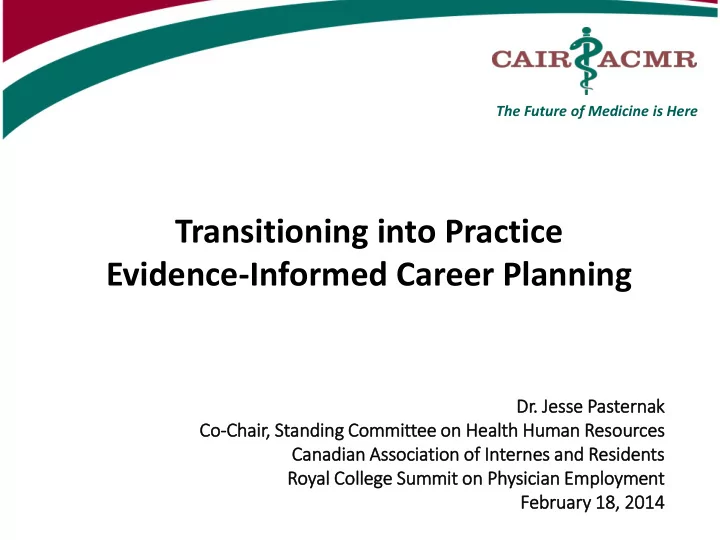

The Future of Medicine is Here Transitioning into Practice Evidence-Informed Career Planning Dr. Je Dr Jesse e Paster ernak Co Co-Chair, Standing Co Committee ee on on He Health th Hu Human Res esou ources Canadia Ca ian Association of of In Internes and Res esid idents Royal Co Colle lege Summit it on on Physician Employment Feb ebruary 18, , 2014
The Learner Context Learner Responsibility Where are the Are there What specialties Canadian/ resources are needed Provincial/ available to most? Regional Needs? meet need? What are my mentors/ Personal teachers telling Career/life goals me?
Emerging Trends - CAIR 2013 Survey Delayed entry into the work force to pursue fellowships Finding after residency employment • 41% plan to pursue post-residency Lack of Career fellowships •2/3 Surgical specialty Counselling • 84 % not confident – SURGERY • 15% not confident – •1 in 3 residents received FAMILY MEDICINE NO Career Counseling •Residents don’t know during residency how to obtain a job • Only 16% residents receive formal career counselling
Other Interesting Survey Points • 67% of residents would be willing to practice in an inner city location • 52% of residents would be willing to practice in a small town or rural location ( 72% of family medicine residents) • 21% of residents would be willing to practice in a geographically isolated or remote location (36% of family medicine residents) 2013 National Resident Survey – CAIR – March 2013
What information will empower learners? Residency Career positions that counselling and reflect job mentorship opportunities Practice where Transfer we train – residency electives/ programs satellite campus Transitions from Social residency into RELIABLE DATA independent Accountability practice
CAIR Activities on Physician HHR TiPS – Transition Into Practice • Started as a pilot in 2011 as an online service to help residents find positions across Canada • Online form indicating preferred practice location, type of practice, specialty, partner employment etc. • TiPS contacts recruiters across the country, on residents’ behalf, to investigate what positions are available that fit with their criteria • TiPS also helps with preparing graduating residents for entering job market – CV, contracts etc.
CAIR Activities on Physician HHR Mentorship Fact Sheet • What does it take to set up a successful mentorship program? • What does it take to be a mentor? • Current state of mentorship in residency • Residency transfers Recruitment Fact Sheet • Highlights employment challenges faced by new graduates • Transitional opportunities • Information on areas of need, job trends, and job availability Career Counselling Fact Sheet • Fitting career counselling formally and informally into residency education
Practical Solutions to Physician HHR Succession planning Orthopedic program at Sunnybrook • Transition strategy developed from both a manpower and educational point of view • Over a period of six years, senior surgeons’ OR time would transition to new surgeons with a mentor-mentee relationship • Highlights: Job satisfaction, mentor-mentee relationship, optimal patient care succession and responsible hospital resources.
Practical Solutions to Physician HHR TiP-ToP (Transition into/out of Practice) • Online matching based on practice/location • Fully transition practice in 2-3 years • Facilitate contracts
CAIR’s Resident Principles on Physician Health Human Resources to Better Serve Canadians 1. Effective, evidence-based workforce planning for Canadian patients and physicians 2. Distribution/allocation of residency training positions that accords with population needs and job availability 3. Recruitment and retention of graduating physicians 4. Career counselling throughout medical training 5. Promotion of social accountability via changes to the formal curriculum and culture building 6. Succession planning and transition of retiring physicians’ practices http://cair.ca/u/elibrary/CAIR%20Principles%20on%20HHR_en.pdf
In Summary…. • Residents need reliable DATA to better inform them about actual Physician HHR trends in Canada • As seen in the CAIR survey, Residents are flexible and want to provide care to all Canadians • Contradictory trends underscore the need for better planning for the right number, mix and distribution of health professionals – Number of physicians has increased faster than population size, yet many communities face shortages of family doctors and specialists, particularly rural and remote areas, and many new specialists face a lack of job opportunities Patient Care Not a Numbers Game – National Health Resources Plan Badly Needed Ottawa, Dec. 6. 2012 CAIR-CMA-CFMS News Release
Thank you Any Questions? Dr. Jesse Pasternak Co-Chair, CAIR Standing Committee on HHR pasterj@mcmaster.ca cair@cair.ca
Recommend
More recommend